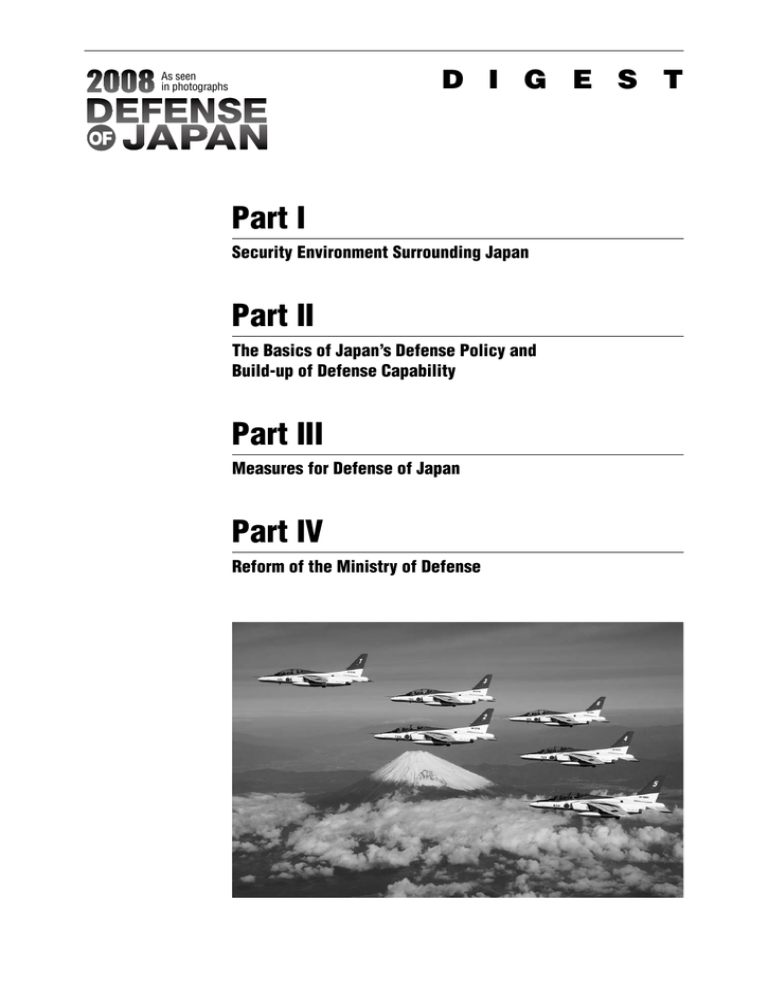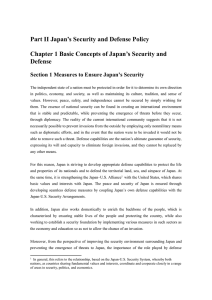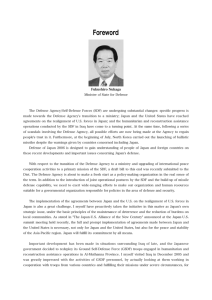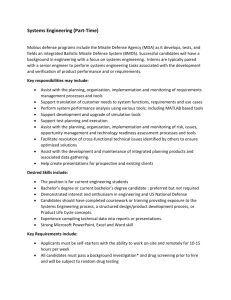Part I Part II D I G E S T
advertisement

D I G E S T As seen in photographs Part I Security Environment Surrounding Japan Part II The Basics of Japan’s Defense Policy and Build-up of Defense Capability Part III Measures for Defense of Japan Part IV Reform of the Ministry of Defense As seen in photographs Part I Security Environment Surrounding Japan Chapter 1 Issues in the International Community Various countries have formed an international alliance, and the fight against terrorism is ongoing. However, terrorism continues to occur at locations throughout the world. The transfer and proliferation of weapons of mass destruction is also cause for concern, and efforts regarding the North Korean and Iranian nuclear issues are continuing. Although the security situation in Iraq remains difficult, the number of attacks and the number of terrorismrelated casualties have fallen, indicating some degree of improvement. Discussion between the U.S. Military and the Iraq Military Officer concerning joint operations [U.S. Department of Defense] Chapter 2 National Defense Policies of Countries The United States continues to promote the review of its military stance and troop withdrawal. In view of the ongoing operations in Iraq and Afghanistan, the United States is aiming to increase the number of troops in the Army and Navy in order to expand military capabilities and lighten the burden on divisions. North Korea’s issues of weapons of mass destruction and ballistic missiles pose serious threats to the peace and stability of East Asia and the international community. Against the backdrop of higher national defense spending, China is working to further modernize its military, and there is a need for vigilant analysis of such implications. Furthermore, China’s breakdown of military spending remains unclear, therefore improved transparency is desirable. Russia continues to promote military reforms and increased activity by the Russian military can be observed in the Far East region. Tu-95 bomber that invaded Japanese airspace on February 9, 2008 As seen in photographs Part II The Basics of Japan’s Defense Policy and Build-up of Defense Capability Chapter 1 The Basic Concepts of Japan’s Defense Policy Peace, security, and independence cannot be ensured by aspirations alone; they must be supported by a wide range of policies, including diplomatic efforts, and cooperation with allied nations along with self-defense capability. Prime Minister Fukuda gives instructions at a meeting of upper-level SDF officials (November 2007) Under the Constitution, Japan’s basic philosophy is to maintain an exclusively defense-oriented policy and not become a military superpower that poses a threat to other nations. In line with this basic philosophy, while continuing to maintain the Japan-U.S. Security Arrangements, Japan continues to ensure civilian control, uphold the three nonnuclear principles, and voluntarily maintain an appropriate self-defense capability. Defense Minister Hayashi giving instructions to officials (August 2008) While the Ministry of Defense continues to uphold the principles of defense policy, it is necessary at all times to make efforts to play a suitable role in response to the changing security environment. The transition of the Defense Agency to the Ministry of Defense in January 2007, as well as Japan’s participation in international peace cooperation activities, are part of such efforts to respond appropriately. Through these activities, the Ministry of Defense is aiming to become an organization that is more resilient to crisis and that can contribute to world peace. Additionally, in recent years, there have been a number of debates regarding the preparation of the “general law” for international peace cooperation. The Ministry of Defense will take into account the views of the ruling parties and the people of Japan in considering these issues. An MSDF destroyer (left) providing fuel to a Pakistani destroyer (February 2008) Chapter 2 The National Defense Program Guidelines and Build-up of Defense Capability The National Defense Program Guidelines for FY 2005 and Beyond (NDPG) enacted in December 2004 set forth two security goals for Japan: to prevent and eliminate direct threats to Japan and to improve the international security environment so it will not pose a threat to Japan. In order to achieve these goals, Japan will pursue a three-pronged approach combining its own efforts with the cooperation of allied nations and the international community. A newly-introduced air refueling and transportation aircraft (KC-767) A destroyer launches an anti-aircraft missile A next-generation fixed-wing patrol aircraft during a test-flight (XP-1) (test model) In addition, in order to realize the new defense capability stipulated in the NDPG, the Ministry of Defense has drawn up a Mid-Term Defense Program for FY 2005-2009, and is proceeding with efforts to improve its defense capability in accordance with the program. In FY 2008, taking into account the security environment surrounding Japan, the Ministry of Defense is proceeding with the modernization of defense capability, construction of organizations to strengthen policy formation and information security functions, and efforts for the peace and security of the international community, while taking into account the efficiency and priority of the build-up of defense capability. New combat vehicle undergoing research and development As seen in photographs Part III Measures for Defense of Japan Chapter 1 Operations of Self-Defense Forces for Defense of Japan and Responses to Diverse Situations The SDF makes efforts to be able to respond appropriately for the defense of Japan as laid out in the NDPG, including response to ballistic missile attacks, response to attacks by guerilla or other special forces, response to air surveillance or invasion of Japan’s airspace or incursion of armed vessels, response to large-scale or extraordinary disasters, and response to new situations or serious aggression. The SDF is making various efforts to be able to respond effectively to ballistic missiles and other situations in the event of changes in the emergency response regarding operations, including the addition of BMD capability to the MSDF Aegis destroyer Kongo in December 2007 and the addition of Patriot PAC-3 to the anti-aircraft troops stationed in the Tokyo area. In addition, Japan is preparing legislation to ensure the peace and security of the nation and the people in situations in which Japan is under attack, and accordingly, the SDF is building up operational structures, and working on an ongoing basis to conduct rapid and effective self-defense operations in a range of circumstances. An Aegis destroyer (aiming to add BMD functions and improve capability) An airborne early warning and control system in flight (E-767) GSDF members transport a casualty to a helicopter transport in the wake of the Niigata Chuetsu Earthquake GSDF personnel undertaking training in the U.S. Chapter 2 Strengthening of the Japan-U.S. Security Arrangements The Japan-U.S. Security Arrangements and the Japan-U.S. Alliance, which forms the basis for the arrangements, are of great significance for Japan’s defense and the peace and stability of the region, as well as for the improvement of the international security environment. In recent years, both Japan and the United States, in order to develop the alliance relationship even further, and in response to changes in the security environment, have conducted Japan-U.S. consultations regarding the future of the Japan-U.S. Alliance, including the realignment of military forces. At the 2+2 meeting in May 2006, the two countries compiled a Roadmap for the Realignment of Forces. GSDF troops hold a meeting on joint operations with U.S. Navy forces An ASDF fighter (F-15) conducts a fuel supply drill with a U.S. Air Force refueling aircraft (KC-135) Former Minister of Defense Ishiba and U.S. Secretary of Defense Gates hold a joint press conference after the Japan-U.S. Defense Ministerial Talks (November 2007) U.S. Air Force minesweeper helicopter conducts a landing drill on an MSDF minesweeper tender (MH-53E) Currently, based on the Law Concerning Special Measures on Smooth Implementation of the Realignment of U.S. Forces in Japan and Related SDF Forces, established in May 2007, various measures are being steadily implemented in Japan, including promotion of the realignment of forces. Even as these efforts progress, Japan is making efforts to maintain the effectiveness of the Japan-U.S. Security Arrangements and improve trust through such means as various Japan-U.S. consultations and preparation of legislation, Japan-U.S. bilateral exercises, exchange in the fields of equipment and technology, and various efforts related to U.S. facilities and base areas in Japan. As seen in photographs Part III Measures for Defense of Japan Chapter 3 Improvement of the International Security Environment The National Defense Program Guidelines aim at improving international security so that threats will not come to Japan along with the defense of Japan. In Iraq, based on the Law Concerning Special Measures on Humanitarian and Reconstruction Assistance in Iraq, the SDF is currently contributing to the reconstruction and stability of Iraq by providing support to the U.N. and allied forces. In the international fight against terrorism, based on the Replenishment Support Special Measures Law established in January 2008, the MSDF is conducting refueling and water supply activities in the Indian Ocean to the vessels of various countries participating in maritime interdiction operations. Concerning international peace cooperation activities, in June 2008, Japan decided to dispatch SDF personnel to the U.N. Sudan Mission (UNMIS) headquarters. In addition, the SDF continues its activities under the U.N. Disengagement Observer Force (UNDOF) in the Golan Heights and the United Nations Mission in Nepal (UNMIN). Moreover, through deepening in terms of quality and expanding in terms of quantity security dialogues and defense exchanges, Japan is actively working toward the improvement of the international security environment. Furthermore, Japan is playing a leading and active role in efforts for arms control, disarmament, and non-proliferation, including the Proliferation Security Initiative (PSI). GSDF troops conduct a briefing at UNMIN headquarters An MSDF air cushion vessel conducts a beaching 12th Tokyo Defense Forum (September 2007) ASDF transportation aircraft loading supplies (C-130H) Chapter 4 Citizens of Japan, the Ministry of Defense and the SDF In order to perform their duties, it is essential for the SDF, which is at the core of Japan’s defense capability, to gain the understanding and support of the people of Japan. Establishing the human and material infrastructure is also vital. The base of defense capability is organizational and human infrastructure. Ultimately, the management of the organization depends not on equipment or systems operations, but on the ability of each SDF member. The Ministry of Defense and the SDF have formed a variety of organizations, centered around the GSDF, MSDF, and ASDF, which comprise the true power of the organization. In order to secure the human infrastructure, various necessary measures are conducted at all stages; troop recruitment and enlistment, and training exercises to retirement and reemployment. In addition, information communications is the foundation of the control and command infrastructure, from central command and various levels of command through to the end troops. The Ministry of Defense and SDF place importance on strengthening this capability. In the area of technological research A matriculation pep rally held by a cooperating organization (Ehime Prefecture) and development, while grasping operational needs, through new research and development methods and introduction of outstanding technologies resulting from industry-academicpublic sector cooperation, efforts are being made to incorporate the latest science and technology. The SDF operates in various forms in local communities with the support and cooperation of the people of Japan. The SDF also conducts cooperative activities to support the livelihood of the people of Japan. These activities further solidify the mutual trust between local communities, the people of Japan, and the SDF. In addition, in order to fully uncover the functions of defense facilities, with the understanding and cooperation of local residents, it is necessary to maintain such facilities in a condition for stable use at all times. The SDF consciously endeavors to minimize the impact of establishment and SDF Ready Reserve personnel participate in disaster drills operation of defense facilities on the lives of local residents. GSDF troops search for missing persons at Komano-yu in the wake of the Iwate/Miyagi Earthquake (June 2008) An MSDF member teaches semaphore code to children (August 2007: Ichigaya) As seen in photographs Part IV The 6th meeting of the Council for Reforming the Ministry of Defense, attended by Prime Minister Fukuda (March 2008) [Cabinet Public Relations Office] The Ministry of Defense and SDF resolve to make wholehearted efforts for reform in order to restore the organizations’ ability to support the peace and independence of Japan. The Council for Reforming the Ministry of Defense, which was established in the Prime Minister’s Office, has convened meetings since November 2007, and in July 2008 a report was released. Taking into account analysis and investigation of the misconducts, the report recommended the following three basic principles for reform: (1) Thorough adherence to rules and regulations, (2) Establishment of professionalism, and (3) Establishment of a management of works that prioritizes execution of duties, with the aim of total optimization. The Ministry of Defense intends to make efforts towards concrete reform of the Ministry at the earliest possible date. A meeting on countermeasures for information leaks headed by former Minister of Defense Ishiba (December 2007) Reform of the Ministry of Defense The unwavering trust of the people of Japan is the most important factor in order to display defense capability and its associated functions. However, in recent years, starting with the arrest of a Vice-Minister suspected of accepting bribes, a succession of incidents have come to light. To address these incidents, the Ministry of Defense and SDF must launch a comprehensive review of standard operating procedures and construct full-fledged policies to prevent a recurrence. Former Minister of Defense Ishiba gives New Year’s Address on the need to reform the Ministry of Defense (January 2008) In addition to the discussions of the Reform Council, the Ministry of Defense has also held discussions at committees established within the Ministry. Preserving secrecy is an indispensable platform for the national defense. Therefore, the Ministry is investigating and implementing various measures to prevent the leakage of information. In addition, the Ministry of Defense has in the past endeavored to acquire equipment in an appropriate and efficient manner. Taking into account the efforts for the promotion of Comprehensive Acquisition Reform in March 2008, going forward the Ministry will continue steady implementation.


